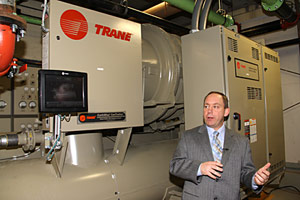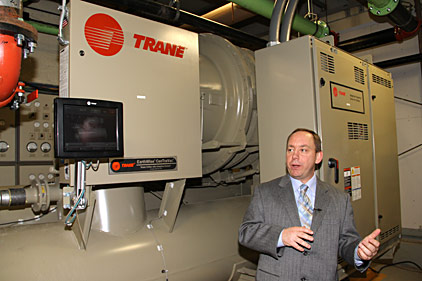
|
| Charlie Holt, account manager for Trane Great Northern Plains, describes a new Trane centrifugal chiller at McGladrey Plaza, which includes a 10-year service agreement to avoid unforeseen repairs and help with maintenance budgeting. This highly efficient solution reduces energy consumption and carbon dioxide emissions equivalent to removing 81 cars from the road each year. |
No wonder that energy efficiency has made its way to the top of many organizations’ to-do lists. With the support of their HVAC industry partners, many building owners and operators are adopting high performance building technologies and operating practices, along with intelligent service models, to improve energy efficiency in both new and existing buildings.
The U.S. Green Building Council (USGBC) says that high performance buildings use 20-30 percent less energy and cost as much as 50 percent less to operate during their total occupied life. Meanwhile, evidence continues to grow that better-performing buildings lead to better-performing organizations and more comfortable, healthy, satisfied, efficient and productive building occupants.
On the other side of the ledger, the “green premium” is shrinking. The USGBC estimates that the incremental cost of making high performance building choices during the design phase of new construction or building retrofit ranges from 0-6.5 percent. Any incremental costs are usually repaid many times in energy and operational cost savings over a building’s long occupied life.
Critical Steps for High Performance Building Implementation
1. Conduct a Critical Systems Audit and Assessment
A critical systems audit (CSA) is a valuable method for determining the current level of performance of building systems such as HVAC, water, lighting, electrical, mechanical, controls, and instrumentation. The CSA process begins by assembling the right team of participants, including internal stakeholders and external partners, such as representatives of a third-party energy services company (ESCO) and HVAC contractor.
Once assembled, the team plays a critical role in the process by defining and quantifying the organization’s high performance building objectives, which may include reducing costs, increasing performance, improving occupant comfort and safety, enhancing occupant productivity, or achieving an environmental certification. The most effective objectives link directly to the mission and key objectives of the organization and the building. In addition, they can be quantified in financial terms. Consider how achieving each objective will add financial value to the organization and estimate the financial impact of failing to achieve the objective, including the impact of system downtime on normal operations, for example.
A CSA includes gathering relevant data about the building’s current performance and comparing its performance to best-in-class buildings. A wide range of benchmarks are available, including the U.S. Energy Information Administration (EIA) Commercial Buildings Energy Consumption Survey (www.eia.gov/consumption/commercial/), and others that an ESCO representative can help identify.
2. Identify and Prioritize Energy Conservation Measures
Using data from the CSA, identify and prioritize energy conservation measures (ECMs), using a disciplined process that considers such factors as savings potential, practicality, commercial viability, risk management, and business differentiation. This process helps organizations determine which ECMs offer the most attractive return on investment, taking the building’s whole lifecycle into consideration.
While many organizations use a simple payback formula to calculate return on investment, today’s sophisticated building modeling and analysis software gives decision-makers the information required to look at the true cost and savings potential of their ECM investments. Evaluating ECMs based on a net present value (NPV) cost analysis provides a more realistic picture of the total savings the ECMs will generate over a building’s total lifecycle. Modeling also helps designers, engineers, and HVAC suppliers perform “what if” calculations and match system capacity to actual requirements.
In the experience of Trane, many ECMs cost nothing to implement or pay for themselves in three years or less. These include temperature resets, sensor recalibration, boiler resets, lighting retrofits, and building automation upgrades, among others. HVAC improvements, such as variable air volume system upgrades, typically pay for themselves in three to eight years. Major HVAC equipment retrofits may require longer payback periods, but still offer attractive return on investment opportunities.
3. Optimize Building Automation Systems
Modern building automation system (BAS) technology enables high performance buildings that are more energy efficient, cost less to operate, provide a better indoor environment for building occupants, and have a smaller environmental footprint. They operate on web-based platforms and use reliable, high-speed Internet connections, enabling building owners and operators to access HVAC and other building systems from any location and at any time of day or night.
The industry-wide adoption of the building automation and control network (BACnet) protocol has enabled a step-change improvement in building system interoperability. In concert with factory-mounted direct digital controls, BACnet allows the BAS to communicate directly with disparate systems including HVAC, lighting, access control, fire detection, and others, creating the opportunity for operators to integrate the operation of formerly independent systems.
Most organizations benefit from working with an energy specialist to ensure that their existing BAS is properly configured and that the facility team is fully trained in its operation. Older buildings equipped with previous-generation BAS technology often choose to upgrade their BAS or install a new system, with estimated payback in the three to eight year range, based on the Trane experience.
4. Adopt a Smart Service Approach
A sound service approach is essential for reaching and maintaining best-in-class levels of building performance. In fact, ASHRAE concluded that a poorly designed building with proven operations and maintenance practices will often perform better over time than a well-designed building that is poorly maintained.
The BAS is the centerpiece of today’s robust intelligent service platforms, which are enabled by technology and the availability of unprecedented levels of system information. Smart service offerings use sophisticated analytics to continuously collect, interpret, and act upon data from building systems and the BAS, giving building operators the ability to manage energy consumption, reduce operating costs, minimize their environmental impact, improve building system reliability and uptime, and resolve more problems sooner, faster, and more effectively.
Numerous studies show that smart service platforms are significantly more efficient than the reactive and preventive maintenance programs that were the industry standard for decades. For example, a study by the Federal Energy Management Program (FEMP) concluded that a reliability-centered maintenance approach is 28-66 percent less expensive than choosing a “run-to-fail” maintenance approach with equipment.
Energy prices continue to rise and organizations of all kinds are under pressure to do more with less — less energy, less budget, less staff. This is a watershed moment for the high performance building movement as more organizations recognize its potential to help them achieve their mission and most important financial and operational goals, with the help of the HVAC industry.
Publication date: 6/24/2013
Want more HVAC industry news and information? Join The NEWS on Facebook, Twitter, and LinkedIn today!


Report Abusive Comment